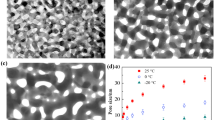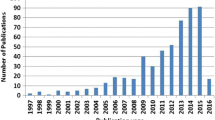Abstract
The ability to create hierarchically porous nanostructures using materials based on metal phosphate and phosphonates is very astonishing. The major drivers of the scientific community are focused on the need to rationalize novel synthetic ways to synthesize these materials under controlled settings especially related to morphology. In this chapter, we have highlighted different synthetic techniques that have been employed in the synthesis of metal phosphonates and how the properties of porous metal phosphonates and phosphates are being impacted. Nanoporous metal phosphonates are proliferating rapidly owing to their versatile applications in different areas, including energy storage, catalysis, environmental intervention, and biology, among others, which are also discussed in this chaptesr. It is expected that the chemistry of porous metal phosphonates and phosphates would advance as a result of their utilization in domains like biology and fuel cells.
Access this chapter
Tax calculation will be finalised at checkout
Purchases are for personal use only
Similar content being viewed by others
References
Shah, H.-U.R., Ahmad, K., Bashir, M.S., Shah, S.S.A., Najam, T., Ashfaq, M.: Metal organic frameworks for efficient catalytic conversion of CO2 and CO into applied products. Mol. Catal. 517, 112055 (2022)
Najam, T., Ahmad Khan, N., Ahmad Shah, S.S., Ahmad, K., Sufyan Javed, M., Suleman, S., Sohail Bashir, M., Hasnat, M.A, Rahman, M.M.: Metal-Organic frameworks derived electrocatalysts for oxygen and carbon dioxide reduction reaction, the chemical record, 22 e202100329 (2022)
Bashir, M.S.: Benign fabrication process of hierarchal porous polyurea microspheres with tunable pores and porosity: Their Pd immobilization and use for hexavalent chromium reduction. Chem. Eng. Res. Des. 175, 102–114 (2021)
Bashir, M.S., Jiang, X., Li, S., Kong, X.Z.: Highly uniform and porous polyurea microspheres: clean and easy preparation by interface polymerization, palladium incorporation, and high catalytic performance for dye degradation, 7 (2019)
Bashir, M.S., Jiang, X., Kong, X.Z.: Porous polyurea microspheres with Pd immobilized on surface and their catalytic activity in 4-nitrophenol reduction and organic dyes degradation. Eur. Polymer J. 129, 109652 (2020)
Jiang, X., Bashir, M.S., Zhang, F., Kong, X.Z.: Formation and shape transition of porous polyurea of exotic forms through interfacial polymerization of toluene diisocyanate in aqueous solution of ethylenediamine and their characterization. Eur. Polymer J. 109, 93–100 (2018)
Bashir, M.S., Jiang, X., Yang, X., Kong, X.Z.: Porous polyurea supported pd catalyst: easy preparation, full characterization, and high activity and reusability in reduction of hexavalent chromium in aqueous system. Ind. Eng. Chem. Res. 60, 8108–8119 (2021)
Bashir, M.S., Ramzan, N., Najam, T., Abbas, G., Gu, X., Arif, M., Qasim, M., Bashir, H., Shah, S.S.A., Sillanpää, M.: Metallic nanoparticles for catalytic reduction of toxic hexavalent chromium from aqueous medium: A state-of-the-art review. Sci. Total Environ. 829, 154475 (2022)
Wei, Q., **ong, F., Tan, S., Huang, L., Lan, E., Dunn, B., Mai, L.: One-dimensional nanomaterials: design, fabrication and applications in electrochemical energy. Storage Adv. Mater 29, 1602300 (2017)
Lv, X.W., Weng, C.C., Zhu, Y.P., Yuan, Z.Y.: Nanoporous metal phosphonate hybrid materials as a novel platform for emerging applications: A critical review. Small 17, 2005304 (2021)
Azhar, U., Huo, Z., Yaqub, R., Xu, A., Zhang, S., Geng, B.: Non-crosslinked fluorinated copolymer particles stabilized Pickering high internal phase emulsion for fabrication of porous polymer monoliths. Polymer 172, 160–169 (2019)
Ma, J., Zhang, L., Geng, B., Azhar, U., Xu, A., Zhang, S.: Preparation of thermo-responsive and cross-linked fluorinated nanoparticles via RAFT-Mediated aqueous polymerization in nanoreactors, molecules, 2017
Azhar, U., Zong, C., Wan, X., Xu, A., Yabin, Z., Liu, J., Zhang, S., Geng, B.: Methyl methacrylate HIPE solely stabilized by fluorinated Di-block copolymer for fabrication of highly porous and interconnected polymer monoliths, Chemistry―A European Journal, 24 11619–11626 (2018)
Mu, J., Liu, J., Ran, Z., Arif, M., Gao, M., Wang, C., Ji, S.: Critical role of CUS in the Au/MOF-808(Zr) catalyst for reaction of CO2 with Amine/H2 via N-Methylation and N-Formylation. Ind. Eng. Chem. Res. 59, 6543–6555 (2020)
Nadeem, M., Yasin, G., Arif, M., Tabassum, H., Bhatti, M.H., Mehmood, M., Yunus, U., Iqbal, R., Nguyen, T.A., Slimani, Y., Song, H., Zhao, W.: Highly active sites of Pt/Er dispersed N-doped hierarchical porous carbon for trifunctional electrocatalyst. Chem. Eng. J. 409, 128205 (2021)
Nadeem, M., Yasin, G., Bhatti, M.H., Mehmood, M., Arif, M., Dai, L.: Pt-M bimetallic nanoparticles (M = Ni, Cu, Er) supported on metal organic framework-derived N-doped nanostructured carbon for hydrogen evolution and oxygen evolution reaction. J. Power Sources 402, 34–42 (2018)
Mysore Ramesha, B., Meynen, V.: Advances and challenges in the creation of porous metal phosphonates, Materials, 13 5366 (2020)
Clearfield, A.: Recent advances in metal phosphonate chemistry. Curr. Opin. Solid State Mater. Sci. 1, 268–278 (1996)
Wilke, M., Bach, S., Gorelik, T.E., Kolb, U., Tremel, W., Emmerling, F.: Divalent metal phosphonates–new aspects for syntheses, in situ characterization and structure solution, Zeitschrift für Kristallographie-Crystalline Materials, 232 209–222 (2017)
Shimizu, G.K., Vaidhyanathan, R., Taylor, J.M.: Phosphonate and sulfonate metal organic frameworks. Chem. Soc. Rev. 38, 1430–1449 (2009)
Assi, H., Mouchaham, G., Steunou, N., Devic, T., Serre, C.: Titanium coordination compounds: from discrete metal complexes to metal–organic frameworks. Chem. Soc. Rev. 46, 3431–3452 (2017)
Siemensmeyer, K., Peeples, C.A., Tholen, P., Schmitt, F.J., Çoşut, B., Hanna, G., Yücesan, G.: Phosphonate Metal-Organic Frameworks: A Novel Family of Semiconductors. Adv. Mater. 32, 2000474 (2020)
Ma, K.-R., Zhang, D.-J., Zhu, Y.-L.: Structure and characterization of a novel 3D lead phosphonate metal-organic framework with cationic layer based on weak Pb–O (N) Contact. Aust. J. Chem. 63, 452–457 (2010)
Gu, D., Schüth, F.: Synthesis of non-siliceous mesoporous oxides. Chem. Soc. Rev. 43, 313–344 (2014)
Soler-Illia, G.J., Azzaroni, O.: Multifunctional hybrids by combining ordered mesoporous materials and macromolecular building blocks. Chem. Soc. Rev. 40, 1107–1150 (2011)
Taylor, J.M., Mah, R.K., Moudrakovski, I.L., Ratcliffe, C.I., Vaidhyanathan, R., Shimizu, G.K.: Facile proton conduction via ordered water molecules in a phosphonate metal− organic framework. J. Am. Chem. Soc. 132, 14055–14057 (2010)
Zhang, L., **, L., Liu, B., He, J.: Templated growth of crystalline mesoporous materials: from soft/hard templates to colloidal templates. Front. Chem. 7, 22 (2019)
Lorzing, G.R., Trump, B.A., Brown, C.M., Bloch, E.D.: Selective gas adsorption in highly porous chromium (II)-based metal–organic polyhedra. Chem. Mater. 29, 8583–8587 (2017)
Wang, N., Sun, Q., Yu, J.: Ultrasmall metal nanoparticles confined within crystalline nanoporous materials: a fascinating class of nanocatalysts. Adv. Mater. 31, 1803966 (2019)
Tian, Y., Xu, S.-Q., Qian, C., Pang, Z.-F., Jiang, G.-F., Zhao, X.: Two-dimensional dual-pore covalent organic frameworks obtained from the combination of two D 2h symmetrical building blocks. Chem. Commun. 52, 11704–11707 (2016)
Zhu, Y.-P., Ren, T.-Z., Yuan, Z.-Y.: Insights into mesoporous metal phosphonate hybrid materials for catalysis, Catal. Sci. & Technol. 5 4258-4279 (2015)
Ma, T.Y., Li, H., Tang, A.N., Yuan, Z.Y.: Ordered, mesoporous metal phosphonate materials with microporous crystalline walls for selective separation techniques. Small 7, 1827–1837 (2011)
El-Refaei, S.M., Russo, P.A., Pinna, N.: Recent advances in multimetal and doped transition-metal phosphides for the hydrogen evolution reaction at different pH values. ACS Appl. Mater. Interfaces. 13, 22077–22097 (2021)
Nitta, N., Wu, F., Lee, J.T., Yushin, G.: Li-ion battery materials: present and future. Mater. Today 18, 252–264 (2015)
Pramanik, M., Tsujimoto, Y., Malgras, V., Dou, S.X., Kim, J.H., Yamauchi, Y.: Mesoporous iron phosphonate electrodes with crystalline frameworks for lithium-ion batteries. Chem. Mater. 27, 1082–1089 (2015)
Bhanja, P., Na, J., **g, T., Lin, J., Wakihara, T., Bhaumik, A., Yamauchi, Y.: Nanoarchitectured metal phosphates and phosphonates: A new material horizon toward emerging applications. Chem. Mater. 31, 5343–5362 (2019)
Pawlowski, S., Crespo, J.G., Velizarov, S.: Profiled ion exchange membranes: A comprehensible review. Int. J. Mol. Sci. 20, 165 (2019)
Arif, M., Yasin, G., Shakeel, M., Mushtaq, M.A., Ye, W., Fang, X., Ji, S., Yan, D.: Hierarchical CoFe-layered double hydroxide and g-C3N4 heterostructures with enhanced bifunctional photo/electrocatalytic activity towards overall water splitting, Materials Chemistry. Frontiers 3, 520–531 (2019)
Arif, M., Yasin, G., Shakeel, M., Mushtaq, M.A., Ye, W., Fang, X., Ji, S., Yan, D.: Highly active sites of NiVB nanoparticles dispersed onto graphene nanosheets towards efficient and pH-universal overall water splitting, Journal of Energy. Chemistry 58, 237–246 (2021)
Arif, M., Yasin, G., Luo, L., Ye, W., Mushtaq, M.A., Fang, X., **ang, X., Ji, S., Yan, D.: Hierarchical hollow nanotubes of NiFeV-layered double hydroxides@CoVP heterostructures towards efficient, pH-universal electrocatalytical nitrogen reduction reaction to ammonia. Appl. Catal. B 265, 118559 (2020)
Khan, K., Liu, T., Arif, M., Yan, X., Hossain, M.D., Rehman, F., Zhou, S., Yang, J., Sun, C., Bae, S.-H., Kim, J., Amine, K., Pan, X., Luo, Z.: Laser-Irradiated holey graphene-supported single-atom catalyst towards hydrogen evolution and oxygen reduction. Adv. Energy Mater. 11, 2101619 (2021)
Zhang, X., Shakeel, M., Li, B., Arif, M., Kong, X., Liu, J., Zuo, S.: Fabrication of 3-D ZnO/CN nanorods for photo-/electrocatalytic water splitting: An efficient morphology for charge carriers transportation. Int. J. Hydrogen Energy 44, 21821–21836 (2019)
Shakeel, M., Li, B., Yasin, G., Arif, M., Rehman, W., Khan, H.D.: In Situ Fabrication of Foamed Titania Carbon Nitride Nanocomposite and Its Synergetic Visible-Light Photocatalytic Performance. Ind. Eng. Chem. Res. 57, 8152–8159 (2018)
Shakeel, M., Arif, M., Yasin, G., Li, B., Khan, A.U., Khan, F.U., Baloch, M.K.: Hollow mesoporous architecture: A high performance Bi-functional photoelectrocatalyst for overall water splitting. Electrochim. Acta 268, 163–172 (2018)
Arif, M., Yasin, G., Shakeel, M., Fang, X., Gao, R., Ji, S., Yan, D.: Coupling of Bifunctional CoMn-Layered Double Hydroxide@Graphitic C3N4 Nanohybrids towards Efficient Photoelectrochemical Overall Water Splitting, Chemistry―An Asian Journal, 13 1045–1052 (2018)
Silbernagel, R., Martin, C.H., Clearfield, A.: Zirconium (IV) phosphonate–phosphates as efficient ion-exchange materials. Inorg. Chem. 55, 1651–1656 (2016)
Bhanja, P., Bhaumik, A.: Porous nanomaterials as green catalyst for the conversion of biomass to bioenergy. Fuel 185, 432–441 (2016)
Fu, R., Hu, S., Wu, X.: Two new molecular zinc phosphonates with bright luminescence for sensing UV radiation. CrystEngComm 15, 8937–8940 (2013)
Zhao, H., Weng, C.-C., Ren, J.-T., Ge, L., Liu, Y.-P., Yuan, Z.-Y.: Phosphonate-derived nitrogen-doped cobalt phosphate/carbon nanotube hybrids as highly active oxygen reduction reaction electrocatalysts. Chin. J. Catal. 41, 259–267 (2020)
Xanthopoulos, K., Anagnostou, Z., Chalkiadakis, S., Choquesillo-Lazarte, D., Mezei, G., Zaręba, J.K., Zoń, J., Demadis, K.D.: Platonic relationships in metal phosphonate chemistry: ionic metal phosphonates, Crystals, 9 301 (2019)
Author information
Authors and Affiliations
Corresponding author
Editor information
Editors and Affiliations
Rights and permissions
Copyright information
© 2023 The Author(s), under exclusive license to Springer Nature Switzerland AG
About this chapter
Cite this chapter
Azhar, U., Bashir, M.S., Arif, M., Sagir, M. (2023). Hierarchically Porous Metal Phosphates and Phosphonates: Emerging Materials Toward Advance Applications. In: Gupta, R.K. (eds) Metal Phosphates and Phosphonates. Engineering Materials. Springer, Cham. https://doi.org/10.1007/978-3-031-27062-8_2
Download citation
DOI: https://doi.org/10.1007/978-3-031-27062-8_2
Published:
Publisher Name: Springer, Cham
Print ISBN: 978-3-031-27061-1
Online ISBN: 978-3-031-27062-8
eBook Packages: Chemistry and Materials ScienceChemistry and Material Science (R0)




